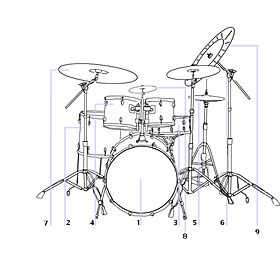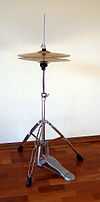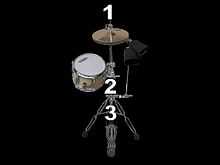Hi-hat
| The drum kit |

 |
|
1 Bass drum | 2 Floor tom | 3 Snare drum |
| Not shown |
|
Sizzle cymbal | Swish cymbal | Crash/ride cymbal |
| See also |
A hi-hat, also spelled hihat, is a type of cymbal and stand used as a typical part of a drum kit by percussionists in rhythm and blues, hip-hop, disco, jazz, metal, rock and roll, house, reggae and other forms of contemporary popular music.[1] It is a standard part of the modern drum kit. The hi-hat consists of two cymbals that are mounted on a stand, one on top of the other, and a pedal which can be used to clash and hold the cymbals together. Open and closed hi-hat refer to notes struck while the two cymbals are apart or together (open or closed), while pedal hi-hat refers to parts or notes played solely with the pedal used to strike the two cymbals. Most cymbal patterns consist of both open and closed notes.
History


Initial versions of the hi-hat were called clangers, which were small cymbals mounted onto a bass drum rim and struck with an arm on the bass drum pedal. Then came shoes, which were two hinged boards with cymbals on the ends that were clashed together. Next was the low-sock, low-boy or low-hat, similar to a modern hi-hat stand, only with cymbals close to the ground. Hi-hats that were raised and could be played by hand as well as foot may have been developed around 1926 by Barney Walberg of the drum accessory company Walberg and Auge.[1] Until the late 1960s, the standard hi-hats were 14 inches (36 cm), with 13 inches (33 cm) available as a less-common alternative in professional cymbal ranges and smaller sizes down to 12 inches (30 cm) restricted to children's kits. In the early 1970s, hard rock drummers (including Led Zeppelin's John Bonham) began to use 15-inch hi-hats, such as the Paiste Giant Beat. In the late 1980s, Zildjian released its revolutionary 12 inch Special Recording hats, which were small, heavy hi-hat cymbals intended for close miking either live or recording, and other manufacturers quickly followed suit, Sabian for example with their 10" mini hats. In the early to mid-1990s, Paiste offered 8 inches (20 cm) mini hi-hats as part of its Visions series; these were among the world's smallest hi-hats. Starting in the 1980s, a number of manufacturers also experimented with rivets in the lower cymbal. But by the end of the 1990s, the standard size was again 14 inches, with 13 inches a less-common alternative, and smaller hats mainly used for special sounds. Rivets in hi-hats failed to catch on. Modern hi-hat cymbals are much heavier than modern crash cymbals, reflecting the trend to lighter and thinner crash cymbals as well as to heavier hi-hats. The other change has been that a pair of hi-hat cymbals are no longer necessarily similar. More typically the bottom is now heavier than the top (but in some cases like the K Custom Zildjian Steve Gadd Session Hats the pattern is reversed for a cleaner chick and cleaner sticking), and may also be vented, this being one innovation to have caught on. Some examples are Sabian's Fusion Hats with holes in the bottom of the hi-hat, and the Sabian X-cellerator, Zildjian Master Sound and Zildjian Quick Beats, Paiste Sound Edge, and Meinl Soundwave. Some drummers even use completely mismatched hi-hats from different cymbal ranges (Zildjian's K/Z hats), of different manufacturers, and even of different sizes (similar to the K Custom Session Hats where the top hat is a sixteenth of an inch smaller than the bottom). Max Roach was particularly known for using a 15 inch top with a 14 inch bottom.
Other recent developments include the X-hat (fixed, closed, or half-open hi-hats) and cable-controlled or remote hi-hats.[2] Sabian introduced the Triple Hi-Hat, designed by Peter Kuppers. In this variation of the hi-hat, the top cymbal moves down and the bottom cymbal moves up simultaneously while the middle cymbal remains stationary.
Drop-clutches are also used to lock and release hi-hats while both feet are in use playing double bass drums. The drop clutch was invented by ragtime drummer Graig Cortelyou . Drop clutches are commercially available from DW Drums, Gibraltar Hardware, The Coady Clutch from Billdidit, and Tama.
Modern stands


The traditional hi-hat stand has the pedal almost directly below the cymbals, which are supported by a hollow vertical tube. The top cymbal is mounted horizontal and bell up, while an adjustment screw allows the bottom cymbal to be either horizontal or slightly tilted.
A narrow metal shaft or rod runs through both cymbals and the tube and connects to the pedal. The top cymbal is connected to the rod with a clutch, and can be lowered by operating the pedal against a spring which holds it up in the "open" position, while the bottom cymbal remains stationary. The height of the top cymbal with the pedal released is adjustable by varying the position of the clutch on the centre shaft. When the hats are closed, the pressure holding them together can be varied by varying the foot pressure.
So, when the foot plate of the pedal is pressed, the top cymbal crashes onto the bottom cymbal (closed hi-hat). When released, the top cymbal returns to its original position above the bottom cymbal (open hi-hat). The spring tension controls the amount of pressure required to lower the top cymbal, and how fast it returns to its open position, and can also be varied.[2]
Some stands allow the feet of the tripod to be adjusted to tilt the stand, or to allow the tripod to rotate on the stand to allow the feet to be positioned among other stands. Other stands omit the tripod and instead attach the stand to the side of the bass drum; This is particular suitable for very large bass drums or double bass drum configurations.
Clutch
There are several patterns of clutch used to support the top cymbal, but the most common uses a knurled collar that is part threaded below the cymbal, and a pair of knurled rings above it. The collar is tightened against the end of the thread, while the rings are tightened against each other.
|
Drop clutch
A drop clutch allows a pair of hats mounted on a conventional hi-hat stand to be closed without use of the pedal.
The drop clutch is provided with a lever that can be operated by hand or struck with a drumstick. This action releases the upper hi-hat cymbal, which falls onto the bottom cymbal and remains there, with gravity then holding the hats loosely closed, and allowing them to be played by the sticks in this position. Operation of the pedal re-engages the clutch and allows the player to resume normal playing.
Drop clutches were developed to allow players using double bass drum pedals to play closed hi-hats without needing to operate the hi-hat pedal, and this remains their primary application.
As it relies on gravity to close the cymbals, the drop clutch gives the player no control over the tension holding them together, and supplies only minimal tension. On the other hand, if the player manually lowers the top cymbal of a standard hi-hat stand before playing, this allows any desired tension to be set, and the pedal can still be used to increase the tension while playing, but not to open the hats or to reduce the tension. Some drummers prefer this technique and reject the drop clutch as too limiting to the sounds available.
A less common alternative is the locking hi-hat pedal, such as the Tama "Cobra Clutch". This and similar high-end locking pedals do allow for control over the tension. It is engaged by pressing a lock pedal separate from the main pedal.[3]
Cable hats
A cable hat or remote hat uses a cable to allow hi-hat cymbals to be positioned independently of the pedal. Operation is otherwise normal.
X-hats
An X-hat is an adaptor to allow a pair of hi-hat cymbals to be mounted in a closed position on a cymbal stand. There is no pedal, the hats are simply kept closed at a constant tension, similarly to a cymbal stack.
The X-hat gives control over the tension holding the hats closed, and allows the player to apply similar tension and produce similar tone to pedal operation, but not to vary the tension while playing.
Playing


When struck closed or played with the pedal, the hi-hat gives a short, crisp, muted percussive sound, sounding like and referred to as a "chick". Adjusting the gap between the cymbals can alter the sound of the open hi-hat from a shimmering, sustained tone to something similar to a ride cymbal. When struck with a drumstick, the cymbals make either a short, snappy sound or a longer sustaining sandy sound depending on the position of the pedal.
It can also be played just by lifting and lowering the foot to clash the cymbals together, a style commonly used to accent beats 2 and 4 in jazz music. In rock music, the hi-hats are commonly struck every beat or on beats 1 and 3, while the cymbals are held together. The drummer can control the sound by foot pressure. Less pressure allows the cymbals to rub together more freely, giving both greater sustain and greater volume for accent or crescendo. In shuffle time, a rhythm known as "cooking" is often employed. To produce this the cymbals are struck twice in rapid succession, being held closed on the first stroke and allowed to open just before the second, then allowed to ring before being closed with a chick to complete the pattern (the cymbals may or may not be struck on the chick).
A right-handed drummer will normally play the hi-hat pedal with his left foot, and may use one or both drumsticks. The traditional hi-hat rhythms of rock and jazz were produced by crossing the hands over, so the right stick would play the hi-hat while the left played the snare drum below it, but this is not universal. Some top modern drummers like Billy Cobham, Carter Beauford, Shawn Drover and Simon Phillips do not cross their hands over at all, playing the hi-hat mounted on the left with the left stick rather than the right. This is called open handed playing. Some drummers, such as Kenny Aronoff, and Jason Finn of The Presidents of the United States of America employ both open handed and cross-handed playing. Some trap sets may also include an extra hi-hat on the right for right-handed players, where it would be awkward to play crossed over. This is shown when drums or cymbals in the middle of the set are played with the hi-hat rhythm. The technique is common with metal genres, such as Lars Ulrich of Metallica and Mike Portnoy formerly of Dream Theater. In both rock and jazz, often the drummer will move the same stick pattern between the hi-hat cymbal and the ride cymbal, for example using the hi-hat in the verses and the ride in the chorus of a song, or using the ride to accompany a lead break or other instrumental solo.
Roger Taylor, drummer for the band Queen, plays with many unique hi-hat techniques, including involuntary opening of the hi-hat on every backbeat for a rhythm emphasis and leaving the hi-hat slightly open when hitting the snare. His trademark hi-hat beat is opening the hi-hat on first and third before hitting the snare.
Phil Rudd of AC/DC also uses distinct hi-hat techniques, which include very heavily accentuating the hi-hat hit on each beat and softer in between.
Charlie Watts of The Rolling Stones uses a technique in which he does not play the hi-hat in unison with the snare drum at all. If playing a standard 8th note pattern, he will play the hi-hat on 1 and 3 and not playing it on 2 and 4 where the snare drum is played.
In much hip-hop, the hi-hat is hit with drumsticks in a simple eighth-note pattern, although this playing is usually done by a drum machine or from an old recording from which the sound of a hi-hat is recorded and loaded into a sampler or similar recording-enabled equipment from which it is triggered. Pioneer Kurtis Mantronik was one of the first to program hi-hat patterns that employed thirty-second notes , although these can be played by a drummer using a technique similar to a drum roll.
| Audio samples | ||
|---|---|---|
| Component | Content | Audio (Ogg Vorbis) |
| Hi-hat | Closed hi-hat | |
| Open hi-hat | | |
| Hi-hat being opened and closed by its foot pedal | | |
| See the Drums page at Wikimedia Commons for more | ||
References
| ||||||||||||||||||||||||||||||